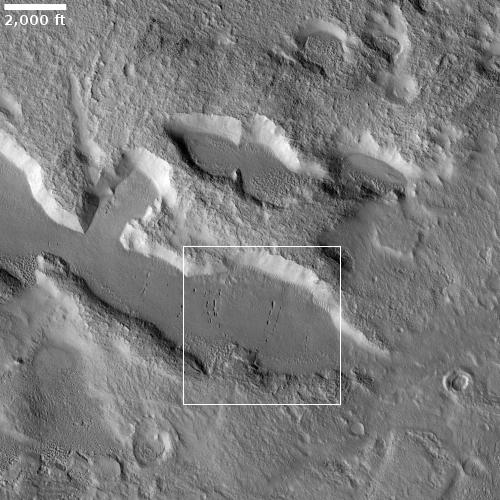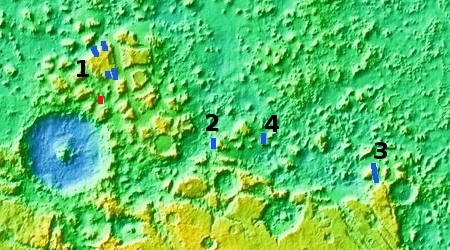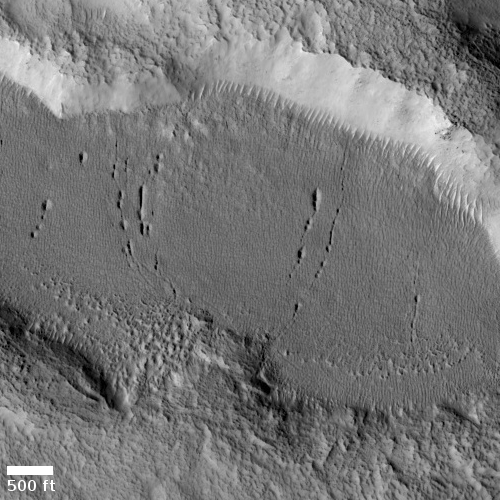Revisiting Mars’ glacier country
With today’s cool image we return to what I have labeled glacier country on Mars, though this time the image shows a Martian glacial feature that while resembling vaguely such features seen on Earth, has an alienness to it that requires some explanation.
The photo to the right, cropped to post here, was taken on March 24, 2020 by the high resolution camera on Mars Reconnaissance Orbiter (MRO). The section I have focused on is the floor of a depression with a number of parallel pits, more or less aligned with the packed north-south ridges that cover the entire floor.
Normally, the north-south ridges would suggest repeated glacial flows moving to either the west or to the east. Such movement could over time, cause the ridges to separate, creating the cracks or pits that we see here. The trouble is that the slope of this depression is very unclear. In fact, the wider view below shows that this depression appears mostly enclosed, or if not it does not seem to be flowing in any particular direction.

While there is a faint suggestion of a slope down to the west, that is hardly obvious or proven. In fact, the surrounding terrain suggests instead no clear slope at all, with its pits and depressions forming in almost a random pattern. Moreover, the depressions all give the impression that they are filled like ponds with ice. Why then would the ice in these depressions have these repeating north-south ridges, almost like waves?
This region, dubbed Protonilus Mensae, is an area of chaos terrain, random mesas separated by criss-crossing canyons, caused by erosion and typically found in the transition zone between the cratered southern highlands and the northern lowland plains. The image itself is of the floor of one of the wider canyons, just to the northeast of the rim of 85-mile-wide Moreux Crater.

The red rectangle in the overview map to the right shows the location of this image. The numbered blue boxes show glacial features that I have previously highlighted:
- 1. Buried glaciers flowing off of Martian mesa
- 2. Brain Terrain on Mars
- 3. How to spot a glacier on Mars
- 4. Glacier country on Mars
As I noted in the fourth post,
If you go to the MRO archive of images from its high resolution camera and go specifically to this location (link here), you will get access to all the high resolution photos so far taken of Protonilus. Click on any red box at this archive and you will see a different MRO image that invokes the same glacial features. If I wanted to, I could post a cool glacier image for practically every single one.
In today’s image, we see that sometimes these Martian glacial features resemble what we’d expect on Earth, but at the same time raise questions that need further exploration.
On Christmas Eve 1968 three Americans became the first humans to visit another world. What they did to celebrate was unexpected and profound, and will be remembered throughout all human history. Genesis: the Story of Apollo 8, Robert Zimmerman's classic history of humanity's first journey to another world, tells that story, and it is now available as both an ebook and an audiobook, both with a foreword by Valerie Anders and a new introduction by Robert Zimmerman.
The print edition can be purchased at Amazon or from any other book seller. If you want an autographed copy the price is $60 for the hardback and $45 for the paperback, plus $8 shipping for each. Go here for purchasing details. The ebook is available everywhere for $5.99 (before discount) at amazon, or direct from my ebook publisher, ebookit. If you buy it from ebookit you don't support the big tech companies and the author gets a bigger cut much sooner.
The audiobook is also available at all these vendors, and is also free with a 30-day trial membership to Audible.
"Not simply about one mission, [Genesis] is also the history of America's quest for the moon... Zimmerman has done a masterful job of tying disparate events together into a solid account of one of America's greatest human triumphs."--San Antonio Express-News
With today’s cool image we return to what I have labeled glacier country on Mars, though this time the image shows a Martian glacial feature that while resembling vaguely such features seen on Earth, has an alienness to it that requires some explanation.
The photo to the right, cropped to post here, was taken on March 24, 2020 by the high resolution camera on Mars Reconnaissance Orbiter (MRO). The section I have focused on is the floor of a depression with a number of parallel pits, more or less aligned with the packed north-south ridges that cover the entire floor.
Normally, the north-south ridges would suggest repeated glacial flows moving to either the west or to the east. Such movement could over time, cause the ridges to separate, creating the cracks or pits that we see here. The trouble is that the slope of this depression is very unclear. In fact, the wider view below shows that this depression appears mostly enclosed, or if not it does not seem to be flowing in any particular direction.

While there is a faint suggestion of a slope down to the west, that is hardly obvious or proven. In fact, the surrounding terrain suggests instead no clear slope at all, with its pits and depressions forming in almost a random pattern. Moreover, the depressions all give the impression that they are filled like ponds with ice. Why then would the ice in these depressions have these repeating north-south ridges, almost like waves?
This region, dubbed Protonilus Mensae, is an area of chaos terrain, random mesas separated by criss-crossing canyons, caused by erosion and typically found in the transition zone between the cratered southern highlands and the northern lowland plains. The image itself is of the floor of one of the wider canyons, just to the northeast of the rim of 85-mile-wide Moreux Crater.

The red rectangle in the overview map to the right shows the location of this image. The numbered blue boxes show glacial features that I have previously highlighted:
- 1. Buried glaciers flowing off of Martian mesa
- 2. Brain Terrain on Mars
- 3. How to spot a glacier on Mars
- 4. Glacier country on Mars
As I noted in the fourth post,
If you go to the MRO archive of images from its high resolution camera and go specifically to this location (link here), you will get access to all the high resolution photos so far taken of Protonilus. Click on any red box at this archive and you will see a different MRO image that invokes the same glacial features. If I wanted to, I could post a cool glacier image for practically every single one.
In today’s image, we see that sometimes these Martian glacial features resemble what we’d expect on Earth, but at the same time raise questions that need further exploration.
On Christmas Eve 1968 three Americans became the first humans to visit another world. What they did to celebrate was unexpected and profound, and will be remembered throughout all human history. Genesis: the Story of Apollo 8, Robert Zimmerman's classic history of humanity's first journey to another world, tells that story, and it is now available as both an ebook and an audiobook, both with a foreword by Valerie Anders and a new introduction by Robert Zimmerman.
The print edition can be purchased at Amazon or from any other book seller. If you want an autographed copy the price is $60 for the hardback and $45 for the paperback, plus $8 shipping for each. Go here for purchasing details. The ebook is available everywhere for $5.99 (before discount) at amazon, or direct from my ebook publisher, ebookit. If you buy it from ebookit you don't support the big tech companies and the author gets a bigger cut much sooner.
The audiobook is also available at all these vendors, and is also free with a 30-day trial membership to Audible.
"Not simply about one mission, [Genesis] is also the history of America's quest for the moon... Zimmerman has done a masterful job of tying disparate events together into a solid account of one of America's greatest human triumphs."--San Antonio Express-News


